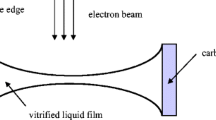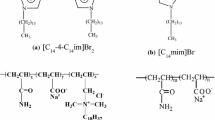Abstract
Electrokinetic (EK) properties, such as the electro-osmotic flow (EOF), are influenced by surfactant adsorption at the solid–liquid interface. With the growing popularity of poly(methyl methacrylate) (PMMA) as the substrate for polymeric-based microfluidics, it is important to understand the effect of surfactants on EOF in these devices. Here, we investigate the effect of surfactant chain length and concentration on the electro-osmotic (EO) mobility induced by three cationic surfactants cetyl trimethylammonium bromide (CTAB), trimethylammonium bromide (TTAB), dodecyl trimethylammonium bromide (DTAB) in PMMA microcapillaries. The EO mobility curve as a function of concentration shows three regimes. First, at very low concentrations below 0.002 mM, the mobility is constant and approximately equal to the value obtained with the surfactant-free electrolyte (1 mM KCl). Next, the EOF reverses and mobility increases linearly with surfactant concentration. Finally, the mobility reaches a plateau at a concentration well below surfactant CMC (0.2-mM CTAB, 0.5-mM TTAB and 2-mM DTAB) and decreases at the vicinity of CMC. Our results show that the rate of change in mobility with respect to concentration is a linear function of chain length and increases with longer-chain surfactants. In addition, we deduce the magnitude of Van der Waals or cohesive energy between the adsorbed alkyl chains from the EO mobility values. For the alkyl trimethylammonium surfactants adsorbed on the hydrophobic surface of PMMA, this energy was found to be 0.114 kT smaller than the reported value for ionic surfactants adsorbed on a hydrophilic surface.





Similar content being viewed by others
References
Alila S, Boufi S, Belgacem MN, Beneventi D (2005) Adsorption of a cationic surfactant onto cellulosic fibers I. Surface charge effects. Langmuir 21:8106–8113
Atkin R, Craig VSJ, Biggs S (2000) Adsorption kinetics and structural arrangements of cationic surfactants on silica surfaces. Langmuir 16:9374–9380
Atkin R, Craig VSJ, Wanless EJ, Biggs S (2003a) The influence of chain length and electrolyte on the adsorption kinetics of cationic surfactants at the silica–aqueous solution interface. Adv Colloid Interface Sci 103:219–304
Atkin R, Craig VSJ, Wanless EJ, Biggs S (2003b) The influence of chain length and electrolyte on the adsorption kinetics of cationic surfactants at the silica–aqueous solution interface. J Colloid Interface Sci 266:236–244
Azadi G, Tripathi A (2012) Surfactant-induced electroosmotic flow in microfluidic capillaries. Electrophoresis 33:2094–2101
Badal MY, Wong M, Chiem N, Salimi-Moosavi H, Harrison DJ (2002) Protein separation and surfactant control of electroosmotic flow in poly(dimethylsiloxane)-coated capillaries and microchips. J Chromatogr A 947:277–286
Bandyopadhyay S, Shelley JC, Tarek M, Moore PB, Klein ML (1998) Surfactant aggregation at a hydrophobic surface. J Phys Chem B 102:6318–6322
Beattie JK (2006) The intrinsic charge on hydrophobic microfluidic substrates. Lab Chip 6:1409–1411
Belder D, Ludwig M (2003) Surface modification in microchip electrophoresis. Electrophoresis 24:3595–3606
Brinck J, Jonsson B, Tiberg F (1999) Influence of long-chain alcohols on the adsorption of nonionic surfactants to silica. Langmuir 15:7719–7724
Caruso F, Serizawa T, Furlong DN, Okahata Y (1995) Quartz-crystal microbalance and surface-plasmon resonance study of surfactant adsorption onto gold and chromium-oxide surfaces. Langmuir 11:1546–1552
Dang F, Zhang L, Hagiwara H, Mishina Y, Baba Y (2003) Ultrafast analysis of oligosaccharides on microchip with light-emitting diode confocal fluorescence detection. Electrophoresis 24:714–721
Dang FQ, Hasegawa T, Biju V, Ishikawa M, Kaji N, Yasui T, Baba Y (2009) Spontaneous adsorption on a hydrophobic surface governed by hydrogen bonding. Langmuir 25:9296–9301
Fa KQ, Paruchuri VK, Brown SC, Moudgil BM, Miller JD (2005) The significance of electrokinetic characterization for interpreting interfacial phenomena at planar, macroscopic interfaces. Phys Chem Chem Phys 7:678–684
Fuerstenau DW, Jang HM (1991) On the nature of alkylsulfonate adsorption at the rutile water interface. Langmuir 7:3138–3143
Garcia AL, Ista LK, Petsev DN, O’Brien MJ, Bisong P, Mammoli AA, Brueck SRJ, Lopez GP (2005) Electrokinetic molecular separation in nanoscale fluidic channels. Lab Chip 5:1271–1276
Goloub TP, Koopal LK (1997) Adsorption of cationic surfactants on silica. Comparison of experiment and theory. Langmuir 13:673–681
Goloub TP, Koopal LK, Bijsterbosch BH, Sidorova MP (1996) Adsorption of cationic surfactants on silica. Surface charge effects. Langmuir 12:3188–3194
Graca M, Bongaerts JHH, Stokes JR, Granick S (2007) Friction and adsorption of aqueous polyoxyethylene (Tween) surfactants at hydrophobic surfaces. J Colloid Interface Sci 315:662–670
Gutig C, Grady BP, Striolo A (2008) Experimental studies on the adsorption of two surfactants on solid–aqueous interfaces: adsorption isotherms and kinetics. Langmuir 24:4806–4816
Huang B, Kim S, Wu H, Zare RN (2007) Use of a mixture of n-dodecyl-beta-d-maltoside and sodium dodecyl sulfate in poly(dimethylsiloxane) microchips to suppress adhesion and promote separation of proteins. Anal Chem 79:9145–9149
Kirby BJ, Hasselbrink EF (2004) Zeta potential of microfluidic substrates: theory, experimental techniques, and effects on separations. Electrophoresis 25:187–202
Manne S, Cleveland JP, Gaub HE, Stucky GD, Hansma PK (1994) Direct visualization of surfactant hemimicelles by force microscopy of the electrical double-layer. Langmuir 10:4409–4413
Mersal GAM, Bilitewski U (2005) Manipulation of the electroosmotic flow in glass und PMMA microchips with respect to specific enzymatic glucose determinations. Microchim Acta 151:29–38
Miller R, Fainerman VB, Makievski AV, Kragel J, Grigoriev DO, Kazakov VN, Sinyachenko OV (2000) Dynamics of protein and mixed protein/surfactant adsorption layers at the water/fluid interface. Adv Colloid Interface Sci 86:39–82
Mosquera V, Ruso JM, Prieto G, Sarmiento F (1996) Characterization of the interactions between lysozyme and n-alkyltrimethylammonium bromides by zeta potential measurements. J Phys Chem 100:16749–16753
Moulik SP, Haque ME, Jana PK, Das AR (1996) Micellar properties of cationic surfactants in pure and mixed states. J Phys Chem 100:701–708
Nagata H, Tabuchi M, Hirano K, Baba Y (2005) Microchip electrophoretic protein separation using electroosmotic flow induced by dynamic sodium dodecyl sulfate-coating of uncoated plastic chips. Electrophoresis 26:2247–2253
Naruishi N, Tanaka Y, Higashi T, Wakida S (2006) Highly efficient dynamic modification of plastic microfluidic devices using proteins in microchip capillary electrophoresis. J Chromatogr A 1130:169–174
Nielsen SO, Srinivas G, Lopez CF, Klein ML (2005) Modeling surfactant adsorption on hydrophobic surfaces. Phys Rev Lett 94:228301
Paria S, Khilar KC (2004) A review on experimental studies of surfactant adsorption at the hydrophilic solid–water interface. Adv Colloid Interface Sci 110:75–95
Penfold J, Staples E, Thompson L, Tucker I, Hines J, Thomas RK, Lu JR (1995) Solution and adsorption behavior of the mixed surfactant system sodium dodecyl sulfate/n-hexaethylene glycol monododecyl ether. Langmuir 11:2496–2503
Rani SA, Pitts B, Stewart PS (2005) Rapid diffusion of fluorescent tracers into Staphylococcus epidermidis biofilms visualized by time lapse microscopy. Antimicrob Agents Chemother 49:728–732
Reuss FF (1809) Sur un nouvel effet de l’electricite galvanique. Mem Soc Imp Nat Moscou 2:327–337
Rodriguez A, Graciani MD, Moreno-Vargas AJ, Moya ML (2008) Mixtures of monomeric and dimeric surfactants: hydrophobic chain length and spacer group length effects on non ideality. J Phys Chem B 112:11942–11949
Schoch RB, Han JY, Renaud P (2008) Transport phenomena in nanofluidics. Rev Mod Phys 80:839–883
Somasundaran P, Fuerstenau DW, Healy TW (1964) Surfactant adsorption at solid–liquid interface—dependence of mechanism on chain length. J Phys Chem 68:3562
Squires TM, Quake SR (2005) Microfluidics: fluid physics at the nanoliter scale. Rev Mod Phys 77:977–1026
Subramanian V, Ducker WA (2000) Counterion effects on adsorbed micellar shape: experimental study of the role of polarizability and charge. Langmuir 16:4447–4454
Tavares MFM, Colombara R, Massaro S (1997) Modified electroosmotic flow by cationic surfactant additives in capillary electrophoresis: evaluation of electrolyte systems for anion analysis. J Chromatogr A 772:171–178
Towns JK, Regnier FE (1991) Capillary electrophoretic separations of proteins using nonionic surfactant coatings. Anal Chem 63:1126–1132
Wakamatsu T, Fuerstenau DW (1968) The effect of hydrocarbon chain length on the adsorption of sulfonates at solid/water interface. In: Weber WJ, Matijević E (eds) Adsorption from aqueous solution. Advances in Chemistry Vol. 79. American Chemical Society, pp. 161–172
Walker SL, Bhattacharjee S, Hoek EMV, Elimelech M (2002) A novel asymmetric clamping cell for measuring streaming potential of flat surfaces. Langmuir 18:2193–2198
Yeung KKC, Lucy CA (1997) Suppression of electroosmotic flow and prevention of wall adsorption in capillary zone electrophoresis using zwitterionic surfactants. Anal Chem 69:3435–3441
Zhang Y, Ping GC, Zhu BM, Kaji N, Tokeshi M, Baba Y (2007) Enhanced electrophoretic resolution of monosulfate glycosaminoglycan disaccharide isomers on poly(methyl methacrylate) chips. Electrophoresis 28:414–421
Acknowledgements
We acknowledge support from the National Science Foundation (Grant CBET-0621216) and the Brown University Graduate student fellowship (A. T. and G. A.).
Author information
Authors and Affiliations
Corresponding author
Additional information
Publisher's Note
Springer Nature remains neutral with regard to jurisdictional claims in published maps and institutional affiliations.
Rights and permissions
About this article
Cite this article
Snider, A., Cui, F.R., Azadi, G. et al. The electrokinetic properties of cationic surfactants adsorbed on a hydrophobic substrate: effect of chain length and concentration. Microfluid Nanofluid 23, 133 (2019). https://doi.org/10.1007/s10404-019-2288-9
Received:
Accepted:
Published:
DOI: https://doi.org/10.1007/s10404-019-2288-9




